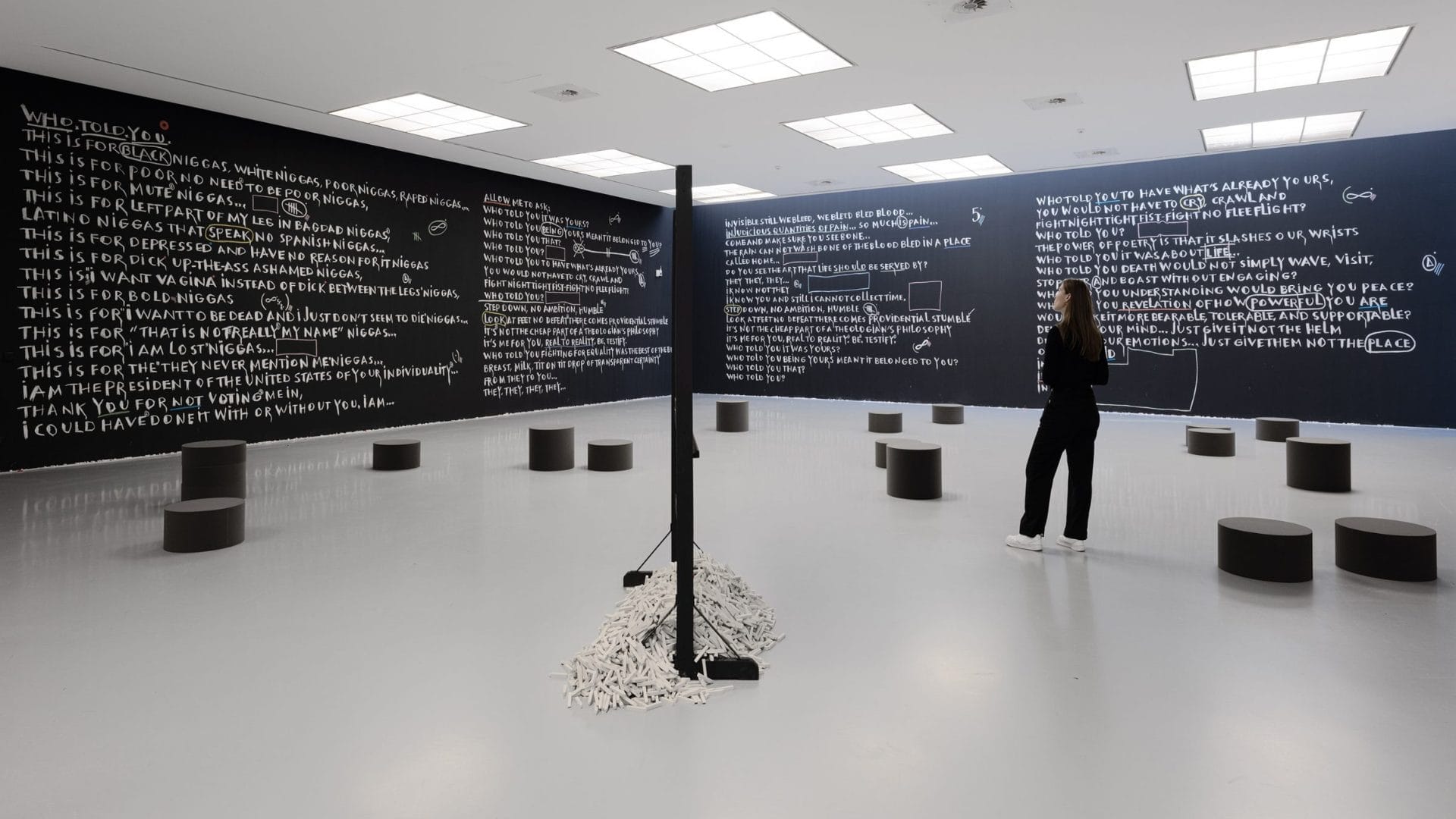
Shattered Identities: Nástio Mosquito’s Carousel of Characters in King of Klowns
“What truly matters?” and “What are we willing to die for?” These provocative questions set the stage for “King of Klowns,” Nástio Mosquito’s powerful exhibition at M HKA in Antwerp. Through this exhibit, Mosquito draws visitors into a complex, immersive world where fluid identities and provocative characters delve into themes of power, ideology, and cultural stereotypes. Using performance, video, and dynamic installations, the Angolan artist transforms art into an inquiry, dismantling and challenging conventional representations.
The exhibition space itself is intentionally disorienting. The first image captures a projection cascading over a tented fabric structure, suggesting a collapsing stage or distorted screen, inviting viewers to lean back and witness fragmented text and surreal visuals from a low angle. This uneven surface disrupts traditional viewing, creating an intimate, almost vulnerable encounter with Mosquito’s layered messages. This setup is as much about making viewers uneasy as it is about amplifying the artist’s themes: challenging narratives, disrupting norms, and breaking down the “correct” ways of seeing and understanding art.

In another room, bathed in an unsettling green light, we encounter a giant projection of Mosquito himself, magnified and arresting. The debris strewn along the floor beneath the screen feels like the aftermath of a personal or cultural upheaval—a visual metaphor for Mosquito’s deconstruction of personas and beliefs. The juxtaposition of his larger-than-life figure with the mess below suggests that each persona he inhabits comes with consequences, urging us to consider the rubble left behind by discarded ideas and identities.
The exhibition’s circular centerpiece—a set of reclined lounge chairs surrounding a multi-screen installation—adds another layer to Mosquito’s exploration of perspective and audience. Here, visitors are invited to sit back, lie down, and consume his visual narratives in a way more akin to a therapeutic or cinematic experience than a traditional gallery setup. This setting blurs the line between passive consumption and active reflection, creating a space where spectators are lulled into contemplation even as Mosquito’s characters confront them with provocative questions on society, stereotypes, power, and identity.
Technically, “King of Klowns” leverages video projection, sculptural installation, and theatrical lighting to fully immerse viewers in Mosquito’s multifaceted narrative style. The projections, often draped over unconventional surfaces, create a three-dimensional effect, drawing viewers into Mosquito’s world rather than presenting it from a comfortable distance. The low, green-tinted lighting and soundscapes add an unsettling dimension, making the environment as much a character in Mosquito’s narrative as his personas. This choice amplifies the artist’s blend of satire and sincerity, positioning the audience as both complicit in and critical of the spectacle of self-representation.
Compared to Mosquito’s earlier works, which were often raw, sharply defined critiques of media and power, “King of Klowns” presents a layered, almost introspective approach. The themes are less overtly critical and more nuanced, exploring the ambiguity of personal and public identities. While he has always embodied different personas to dissect social and cultural issues, this exhibition feels like a culmination of those experiments—a retrospective and forward-looking journey where Mosquito confronts not only the world but himself.

Leaving “King of Klowns,” one feels both exhilarated and unsettled. Mosquito’s invitation to question what we care about and what we’re willing to stand for lingers, prompting us to reexamine our own personas and the boundaries we uphold or challenge in our daily lives. Through humor, discomfort, and a deft use of space, Mosquito offers a complex, liberated view on identity and expression that refuses to simplify or categorize. Instead, he invites us to embrace the chaos and perhaps find a clearer reflection of ourselves within it.


fakewhale
Founded in 2021, Fakewhale advocates the digital art market's evolution. Viewing NFT technology as a container for art, and leveraging the expansive scope of digital culture, Fakewhale strives to shape a new ecosystem in which art and technology become the starting point, rather than the final destination.
You may also like
Fakewhale in conversation with Franc Archive
Coming from a background in street art and now working across digital installations and performative
11 QUESTIONS – Erris Huigens
Alejandro Javaloyas asks 11 questions to an abstract artist about their work and inspiration. Introd
Art and Commerce: From Adversity to Alignment
The art market, with its intricate dynamics and fluctuations, has long been a source of tension for




